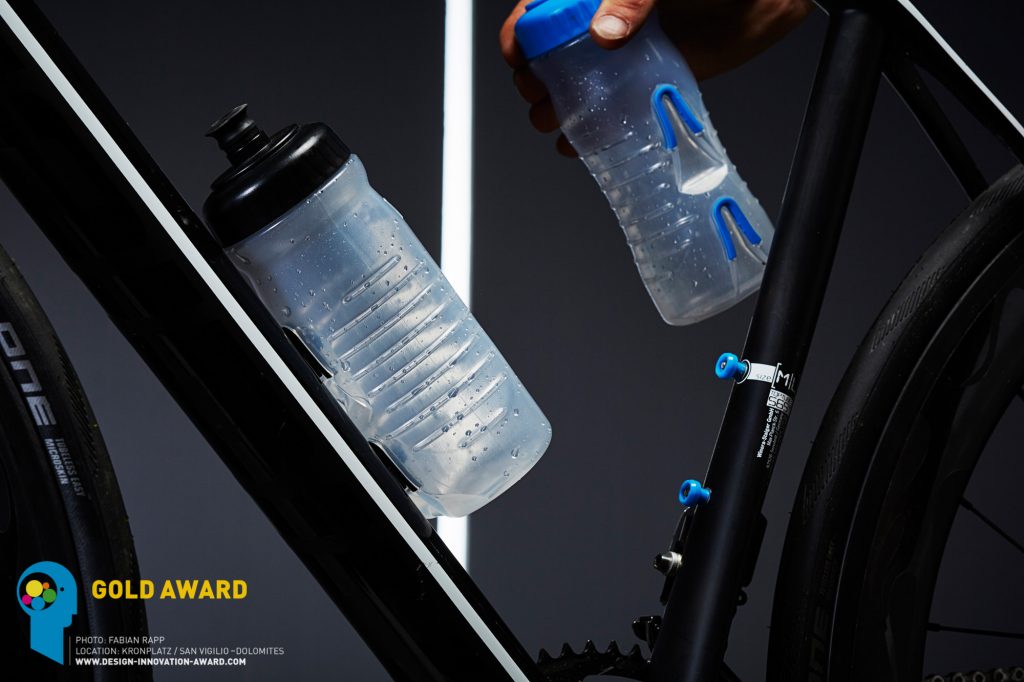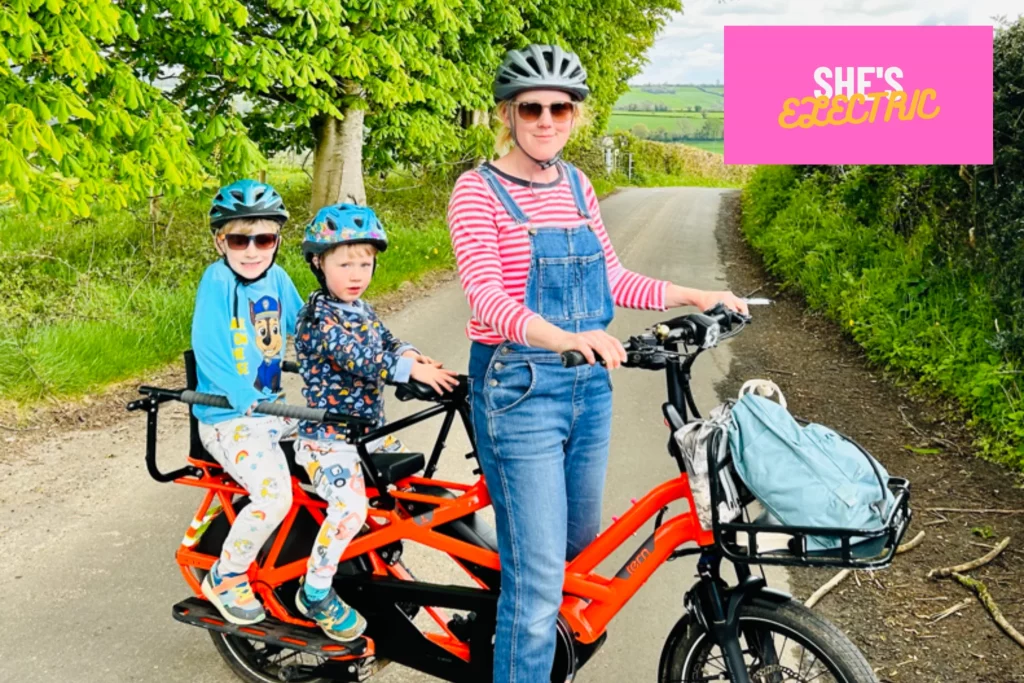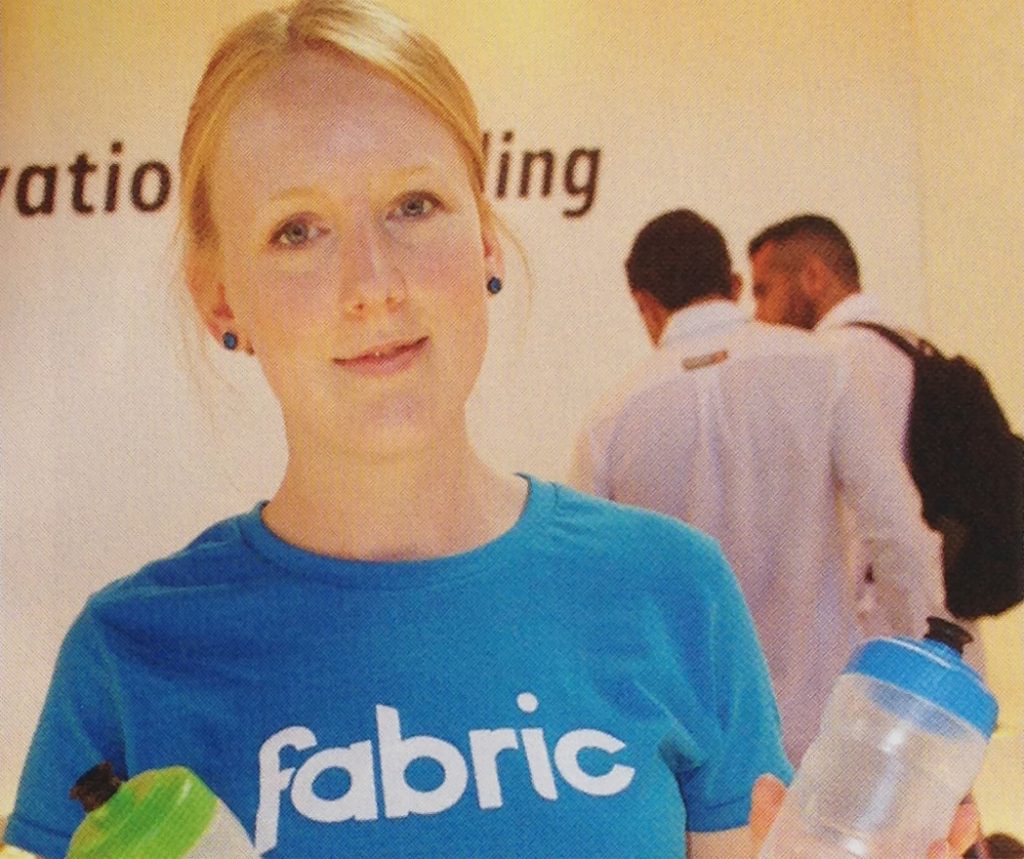Design & Innovation Award – Gold
Fabric Cageless Bottle, designed for fabric by Rebecca Crowder.

The mission of the Design & Innovation Award is to shape the bicycle world in a positive way. It also serves as a forum for creativity, visionary ideas as well as the industry’s most innovative products. More than 40 experts from 10 countries joined this year’s event to test, analyze and judge the best and most innovative products of 2016 in Kronplatz/San Vigilio – Dolomites. The Gold Award recognises either perfect product design and function, or innovation that sets a new standard and inspires future product generations and forward-thinking approaches.
“With their new Cageless Water Bottle, Fabric have challenged tradition, and the end result is a masterpiece of design. By incorporating a simple, new mounting system that uses the existing bottle bosses in a very different way, Fabric have revolutionised the function of the simple bottle. Two tiny plastic studs are screwed into the bottle cage bosses, weighing only 1.5 g each, and a BPA-free bottle simply slots into place. The connection is firm and secure, and despite the test team’s best efforts, the bottle could not be shaken loose. When the bottle is not in place, all that is left behind are the two almost invisible, impressively light studs, keeping the lines of the bike clean and tidy. In use, the inexpensive bottle is initially a little trickier to locate than some caged designs, but all you need is some practice. From a design standpoint, the form and lightweight function is unmatched. Furthermore, the Fabric Cageless Bottle design will inspire other designers to question the established, think the unthinkable, and create truly new solutions to issues that others have overlooked.”
www.designandinnovationaward.com 05.02.2016 • by Noah Haxel
She’s Electric Role model Profiling
BY CAZ CONNELLER ON JULY 26, 2023
The fourth Role Model in our She’s Electric campaign is Rebecca Crowder!

Tell us a bit about yourself?
My name is Rebecca and I live in a rural village just a 15 minutes drive away from the beautiful city of Bath in the South West of England. I have two young energetic children, both boys, the oldest is at school and the youngest is currently at pre-school.
I love spending time outdoors, and do a lot of hill walking, (we live in a very hilly area so any walk will consist of hills!) cycling and gardening. I am a product designer by profession, and own my own product design business called Blue Dots Design which specialises in designing products for the cycling and outdoor adventure sports industries. I really love my job, and I consider myself very fortunate to collaborate with well known global brands on their projects.
What e-bike do you ride?
I ride a Tabasco red Tern GSD, which is an electric cargo bike. I have a front rack which I use for bags/coats/drinks/snacks etc etc, two rear seats and safety rails as my particular set up. I did use a Thule Yepp seat for a year before my youngest son outgrew it.
How did you get started on an e-bike and what was the experience like?
I actually started off being given a Tern GSD by a client to try for 6 months. I was working on an e-bike accessories project with them, and they wanted me to be riding one daily and testing out the bike along with the product prototypes I designed for them.
To start with I wasn’t bought into it at all and couldn’t see myself riding it. I hadn’t seen many of them around and felt a bit self conscious. After a day or two however I was completely hooked. I loved it! It was so smooth to ride, easy to use, really easy to climb on and off in whatever clothes I chose to wore that day (jeans, trousers, leggings and a pinafore etc) the children loved it and I just found it so damn useful! I really enjoyed using it as a car replacement for short local journeys to school, charity shop drop-offs and soon I stared to go further afield to the supermarket or riding out just for fun on my lunch break.
The low centre of gravity makes it super stable, so it feels completely safe for the children to climb on and off – under supervision of course. It also means when it is fully loaded with luggage it doesn’t feel awkward to ride.
I was genuinely gutted when the client asked for it back, and I felt quite low for a good week or so. I left it a couple of months before I ordered my own, and that was long enough to be without one.
How does your e-bike benefit your life?
In so many ways. I have noticed my fitness has improved since using the bike for journeys rather than the car. Knowing it’s there, I make an effort to use it for journeys that would have otherwise have been driven.
I love being out in the fresh air on it too, and living in a rural area I get to see so much more of the countryside and nature that you just don’t notice from being in a car. I use it to cycle into Bath or Frome too for client meetings, or days out shopping. It takes longer to cycle into Bath than it does to drive, but using the cycling infrastructure round us makes it so safe. It’s also free to lock up a bike in the city centre so avoids paying parking charges or bus fares. It is easier and quicker to get off and lock up a bike in a city centre, than to find a parking space and walk to the shops. With the bike I can stop right outside. The same applies to school runs too. It takes me less time to cycle the boys to school, get off and drop them both off and cycle home again than it does to drive. Because by the time I have parked the car, wrestled the boys out or their carseats and walked to the school from the car I could be half way home again using the bike.
There is a whole network of Sustrans routes near us, so if I have any meetings in Bath or Frome I cycle to those using the Sustrans network of disused railway lines. It helps my credentials too if I arrive to a work meeting for a cycling project by bike!
What’s a typical trip for you?
The most frequent journeys for us are the school drop off and pick up. I unlock my bike and take it out of the bike shed. After the boys and their bags are loaded on we head out. The school is 3 miles away down country lanes and a very steep hill! The battery assist is an absolute game changer for hills. No way would I be able to cycle 38kgs of children up a steep hill without any kind of assistance. I can cycle right up to the school gate and drop them off quickly and safely before cycling home. During the day I tend to leave the boys bike helmets fastened to the rear safety rails. It means there is no way I will forget them when I go to collect the boys at school pick up time.
What’s one thing you would say to inspire more women to ride an electric bike?
I would say from my own experience; don’t knock it until you try it! I had my reservations before I tried it, but now I wouldn’t be without my electric cargo bike for any price. I love it. Also, don’t be put off by helmet hair… there are plenty of ways to get around this issue!!
Make sure to check out Rebecca’s wonderful product design business via her website or Instagram!
Designer of Fabric’s cage killer wows Eurobike

Fabric’s re-invention of the water-bottle-and-cage combo by scrapping the cage has gone down well at Eurobike. And product designer Rebecca Crowder, has also been a hit.
Rebecca Crowder’s design dispenses with a bottle cage. Instead, two plastic studs are swapped out for the bottle cage bolts, and the bottle attaches via proprietary slots. Tested on rough terrain, the bottles don’t rattle free, said Nick Larsen, Fabric’s founder.
Getting rid of the cage leads to cleaner lines, said Larsen. It also has another benefit, said Crowder, designer of the bottle: “We can make all sort of different shapes and sizes of bottle, allowing us to create bespoke designs. We’ll be able to go wild.”
The bottle cage killer has been brought to market rapidly. “We came up with the concept after returning from Eurobike last year,” said Crowder.
“The whole thing about Fabric is doing stuff differently. What can you change about a water bottle other than the way it goes on a bike? So that’s how we came up with the two-stud system.”
It has been a baptism of fire for Crowder – she joined Fabric two months before Eurobike last year having been poached from a prototyping company.
Fabric is owned by the Cycling Sports Group, which also owns Cannondale, Mongoose and GT. Fabric’s Nick Larsen is also founder of Charge, CSG’s boutique brand.
As well as the ditch-the-cage system Fabric makes multi-tools, saddles and grips.
www.bikebiz.com 28th August 2015
Rouleur
Industry outsiders
Larsen has another significant card to play in his quest for innovation: the industrial designers he employs are recruited from outside of the cycle industry. Ian Redfern, who headed development of the ALM saddle, once designed kitchen knives. And product designer Rebecca Crowder joined from a business making clay models for the likes of Aardman Animations.
“In the interview, I said to Nick, ‘I have a bike, but I don’t know what the bits are called’,” she recalls. “He said, ‘No, that’s fine. That’s what we wanted’.”
Water carrier
Crowder has worked closely with Larsen on the development of Fabric’s cageless water bottle, a system of beguiling simplicity. A groove in one side of the bottle slides on to two plastic ‘hats’, one each mounted on the downtube bosses. It is an improvement on similar, but failed designs from past eras.
Larsen has high hopes for the product, one he claims is the lightest and most aerodynamic on the market. It is also among the most versatile, easily swapped from bike to bike, and soon to be produced in numerous iterations, including with a handle.
He compares the cageless bottle to the SPD pedal, both in terms of the initial reservation of enthusiasts and Shimano’s dogged extolling of its value to the consumer until it became the norm.
Design stories: Charge/Fabric
Gear 15.03.16 Words: Rouleur